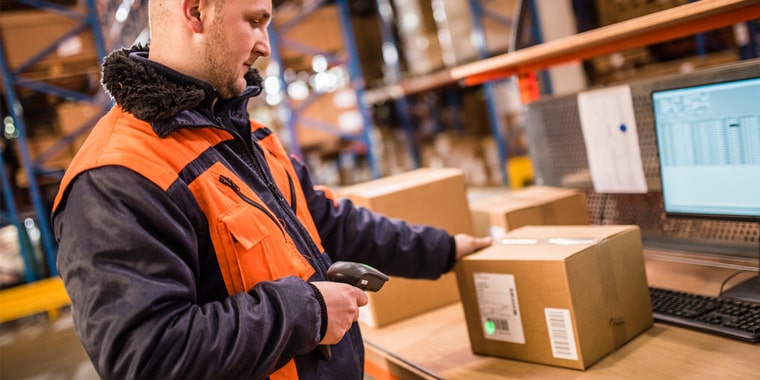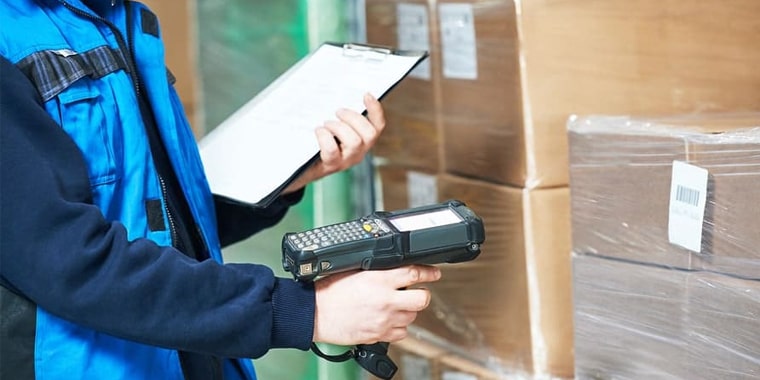Almost anything you buy today has barcodes – from apples in the supermarket to the latest Smartphones, you can find them everywhere.
In fact, they have become so commonplace that we have almost stopped noticing them.
Barcodes were invented over 7 decades ago, and today they are important tools for any business.
They help in bringing greater efficiency to inventory control and sales operations and can keep track of product movement across the supply chain.
To put it simply, a barcode is a rectangle containing upright black lines of differing thickness, numbers, and white space, which combine and identify products and their details.
Scanners in computers, mobile devices, and standalone scanning devices are capable of using the unique bar–space–number combination to extract the product data.
As scanners (both handheld and checkout station ones) can read them and instantly retrieve information, they can save time and money, as it eliminates the need for a manual search for getting product information.
ALSO READ: Inventory Management Trends to Watch Out for
1 Dimensional and 2 Dimensional are the two main types of barcodes.
The former is found on groceries that one buys, and the second is generally seen on ads or some products, and it takes the user to the company website.
1-D or linear barcodes are the most popular and can be easily read by most scanners.
Universal Product Code in the US and European Article Numbers in Europe are the most commonly used linear barcodes.

0 and 1 are represented by the width of the black bars, and their sequence signifies a number between 0 and 9.
The scanner’s processor or the computer connected to it contains information on what product is mapped to each unique bar and space combination; it performs some mathematical operations to identify the right item and displays it on the screen.
In warehouses, barcodes may encode product features like color, size, location, etc. so that the company gets inventory details and fulfill orders or physically count inventory quickly.
In a retail store, the barcode may contain the name and price of an item an employee needs to ring up a customer.
Barcodes can be used by organizations to track products across their life cycles – from production to distribution, buying, maintenance, and repair.
ALSO READ: Advantages of ABC Analysis in Inventory Management
Barcodes have a uniform design to enable scanners to read them and send the coded information to a computer.
Through different elements, a barcode may contain information regarding manufacturer, product category, origin country, and so on.
The different elements are the check digits, stop character, quiet zones (white spaces), start characters, data, and so on.

Black upright lines with numbers below – these linear barcodes are the ones we see most often, they contain letters, numbers, and symbols, each mapping to product attributes.
To function correctly, a 1-D barcode should be linked to a database.
These codes are used on books, consumer goods, shipping labels, and loyalty cards.
ALSO READ: Future of Enterprise Resource Planning
These are 2D or QR codes and are capable of storing more information like website URLs, quantity, images, etc., and do not need to be linked to a database to reveal this information.
QR codes often direct users to the product website.
QR codes for inventory tracking are being increasingly used where meticulous tracking of products or components is necessary, like pharmaceuticals and medical equipment.
This type of 2D barcode is capable of storing files and have the exceptional capability to check errors.
It is robust and can be read even if damaged, so often used on appliance electric rating plates, circuit boards, surgical tools, etc.
ALSO READ: Guide on Zero Inventory
1D barcodes have lines in one direction while 2D can have both, and also other shapes – allowing them to contain up to 2000 characters, against 80 in 1D barcodes.
2D barcodes also necessitate sophisticated scanners or smartphones; they can also be small in size, making them perfect for small items.

As they give a quick and unambiguous ROI, barcodes are very popular.
They offer benefits like:
By eliminating manual data entry, you can achieve more accuracy in product information.
Barcode errors are almost nonexistent
ALSO READ: Why is Cycle Stock Important for Your Business?
Whenever a barcode is scanned, the inventory and sales figures in the company’s systems are instantly updated, offering real-time, updated data to businesses.
This helps in calculating valuable KPIs that offer insights into the inventory and sales performance.
Employees don’t need much training as barcodes are self-explanatory, and reduce need for memorizing.
Even without knowing product codes, employees can be productive.
ALSO READ: The Ultimate Guide to Dropshipping
Companies can avoid spending excessively on products and improve their inventory management.
Employees have access to updated inventory data which empowers them to make informed decisions regarding purchases and discount offers, which eventually help in reducing inventory holding costs and avoiding dead stocks – translating into long-term profitability.
The initial financial outlay is not as huge as for other similar systems, but this system offers immense value.
Small companies can start small with just a few barcodes for internal use and can increase the number as they grow, without incurring huge cost.
ALSO READ: What is Product Bundling in Inventory Management?
Businesses have to know current stock levels and where they are located at any given time.
Warehouse employees or mounted automated scanners scan new products 1) when they come in, and 2) when they are shipped out.
Every SKU has a barcode linked to a database with the requisite product data.
Thus, barcodes being scanned when products come in and go out helps in inventory management.
Businesses use QR code for asset management, for tracking assets used to support their everyday operations – vehicles, equipment, computers, etc.
When combined with asset tracking software, barcodes enable businesses to track the asset status and location, storing important information regarding repairs and maintenance, as such assets are held by companies for years and used for prolonged periods.
Barcodes for mobile items like vehicles and computers may also show details of last usage.
This helps management understand the condition and usage of various assets, to plan for the future.
ALSO READ: What is Asset Depreciation and Why is it Important?
Invoices with barcodes become easy for tracking accounts payable and receivable, and to also link them to specific customers.
Scanning the barcode at payment receipt can ensure that the correct account is credited, and so on – this can also speed up the fulfilment process.
With invoice printouts, warehouse workers can simply scan the code to see which items to pick from where, eliminating errors, and can scan barcodes of items after picking to ensure all items are as per the order.
ALSO READ: What are the Benefits of e-invoicing for your Business?
Companies can also use barcodes to track packages and documents sent by mail by just scanning all packages before sending them to the courier companies.
This links tracking data to the order which can be sent to customers to check order status.
Mail merge is the linking of a spreadsheet or similar data source with other documents to populate the data automatically in the predefined fields.
Companies use mail merges to generate barcodes for specific item batches easily – and is more efficient than manual handling.
![]()
It is a simple and economical method for businesses to manage and monitor their physical assets.
Barcode labels and readers make it possible to perform lifecycle management of assets and for inventory control.
Every organization needs physical space, land, appliances, furniture, office supplies, computers, and accessories to function; manufacturers and other businesses may need heavy machinery and other equipment.
All these are assets, needed for effective functioning, revenue generation, or for maintaining operations.
The tangible, durable equipment or properties used by organizations in their operations for revenue generation, are called fixed assets.
ALSO READ: ERP software in Warehouse & Fixed Asset Management
Their value depreciates as they are used, and this has to be recorded in the company’s books of accounts.
Without that, it is not possible to know what the fixed assets the company owns, their location, and their status.
This kind of neglect can cause assets to be misused, damaged, stolen, or lost, leading to heavy expenses, taxation mistakes, frustrations, and waste of time.
With QR code equipment tracking or barcode asset tracking, you can allocate unique barcodes to every fixed asset.
When it’s scanned, it will reveal the chief properties of the asset, its location, and any other important information the company wants.
Along with asset tracking software, barcodes can connect users with information like its entire history of maintenance, depreciation, maintenance schedules, relevant photos, or any other relevant records.
ALSO READ: What is a Ledger in Accounting?
Tracking IT assets is critical because most companies today invest huge money in them.
Failing to track those assets can cause a serious dent in the bottom line.
IT asset tracking offers several important benefits – mainly, transparency in your efforts of IT asset management.
It helps in recognizing and eliminating flawed IT assets, say those that have frequent problems, leading to workflow disruptions and downtimes.
It also affords greater visibility into IT assets, enabling management to prevent duplicate purchasing and identifying idle assets, reassigning them to teams that need those assets instead.
ALSO READ: What are Backorders and How to Manage or Avoid Them?
A platform for IT asset tracking helps businesses to stay updated with their records when they remove certain assets.
Precise maintenance of records eliminates ghost assets and companies can avoid paying insurance for assets no longer in their inventory.
You can also configure notifications to make sure that the correct procedures are followed for the disposal or retirement of fixed assets.
Customized alerts allow IT managers to stay on top of routine services, updates, and maintenance to ensure maximum uptime and efficiency, and minimal risk from cyber security threats.
![]()
QR code asset tracking offers multiple benefits:
Modern organizations realize that barcode asset tracking is critical for success, and not merely for accounting and compliance purposes.
While earlier, organizations had to depend on expensive handheld scanners for the purpose, today QR codes and barcodes can be scanned by Smartphones and tablets, which can be used for various other purposes too.
You simply need to have a robust asset-tracking software solution installed.
Tranquil asset management software is a robust solution that can help you do all this and more. Schedule your free demo now to know more! We are happy to explain how it works.